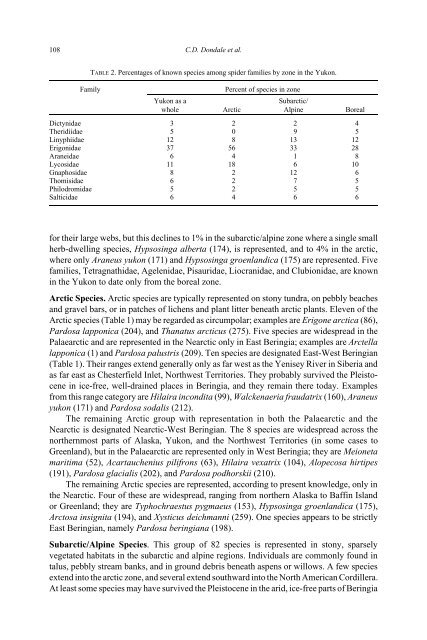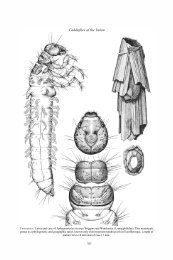Spiders of the Yukon - Department of Biological Sciences
Spiders of the Yukon - Department of Biological Sciences
Spiders of the Yukon - Department of Biological Sciences
Create successful ePaper yourself
Turn your PDF publications into a flip-book with our unique Google optimized e-Paper software.
108 C.D. Dondale et al.<br />
TABLE 2. Percentages <strong>of</strong> known species among spider families by zone in <strong>the</strong> <strong>Yukon</strong>.<br />
Family Percent <strong>of</strong> species in zone<br />
<strong>Yukon</strong> as a<br />
whole Arctic<br />
Subarctic/<br />
Alpine Boreal<br />
Dictynidae 3 2 2 4<br />
Theridiidae 5 0 9 5<br />
Linyphiidae 12 8 13 12<br />
Erigonidae 37 56 33 28<br />
Araneidae 6 4 1 8<br />
Lycosidae 11 18 6 10<br />
Gnaphosidae 8 2 12 6<br />
Thomisidae 6 2 7 5<br />
Philodromidae 5 2 5 5<br />
Salticidae 6 4 6 6<br />
for <strong>the</strong>ir large webs, but this declines to 1% in <strong>the</strong> subarctic/alpine zone where a single small<br />
herb-dwelling species, Hypsosinga alberta (174), is represented, and to 4% in <strong>the</strong> arctic,<br />
where only Araneus yukon (171) and Hypsosinga groenlandica (175) are represented. Five<br />
families, Tetragnathidae, Agelenidae, Pisauridae, Liocranidae, and Clubionidae, are known<br />
in <strong>the</strong> <strong>Yukon</strong> to date only from <strong>the</strong> boreal zone.<br />
Arctic Species. Arctic species are typically represented on stony tundra, on pebbly beaches<br />
and gravel bars, or in patches <strong>of</strong> lichens and plant litter beneath arctic plants. Eleven <strong>of</strong> <strong>the</strong><br />
Arctic species (Table 1) may be regarded as circumpolar; examples are Erigone arctica (86),<br />
Pardosa lapponica (204), and Thanatus arcticus (275). Five species are widespread in <strong>the</strong><br />
Palaearctic and are represented in <strong>the</strong> Nearctic only in East Beringia; examples are Arctella<br />
lapponica (1) and Pardosa palustris (209). Ten species are designated East-West Beringian<br />
(Table 1). Their ranges extend generally only as far west as <strong>the</strong> Yenisey River in Siberia and<br />
as far east as Chesterfield Inlet, Northwest Territories. They probably survived <strong>the</strong> Pleistocene<br />
in ice-free, well-drained places in Beringia, and <strong>the</strong>y remain <strong>the</strong>re today. Examples<br />
from this range category are Hilaira incondita (99), Walckenaeria fraudatrix (160), Araneus<br />
yukon (171) and Pardosa sodalis (212).<br />
The remaining Arctic group with representation in both <strong>the</strong> Palaearctic and <strong>the</strong><br />
Nearctic is designated Nearctic-West Beringian. The 8 species are widespread across <strong>the</strong><br />
nor<strong>the</strong>rnmost parts <strong>of</strong> Alaska, <strong>Yukon</strong>, and <strong>the</strong> Northwest Territories (in some cases to<br />
Greenland), but in <strong>the</strong> Palaearctic are represented only in West Beringia; <strong>the</strong>y are Meioneta<br />
maritima (52), Acartauchenius pilifrons (63), Hilaira vexatrix (104), Alopecosa hirtipes<br />
(191), Pardosa glacialis (202), and Pardosa podhorskii (210).<br />
The remaining Arctic species are represented, according to present knowledge, only in<br />
<strong>the</strong> Nearctic. Four <strong>of</strong> <strong>the</strong>se are widespread, ranging from nor<strong>the</strong>rn Alaska to Baffin Island<br />
or Greenland; <strong>the</strong>y are Typhochraestus pygmaeus (153), Hypsosinga groenlandica (175),<br />
Arctosa insignita (194), and Xysticus deichmanni (259). One species appears to be strictly<br />
East Beringian, namely Pardosa beringiana (198).<br />
Subarctic/Alpine Species. This group <strong>of</strong> 82 species is represented in stony, sparsely<br />
vegetated habitats in <strong>the</strong> subarctic and alpine regions. Individuals are commonly found in<br />
talus, pebbly stream banks, and in ground debris beneath aspens or willows. A few species<br />
extend into <strong>the</strong> arctic zone, and several extend southward into <strong>the</strong> North American Cordillera.<br />
At least some species may have survived <strong>the</strong> Pleistocene in <strong>the</strong> arid, ice-free parts <strong>of</strong> Beringia

















